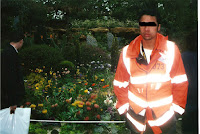There are so many advantages to container displays and the possibilities to be imaginative and inspired are endless.
Upright plants for stunning colour with trailing varieties to soften the effect.
A statement shrub, or a subtle Hosta for shade
First you need to decide on what sort of pots or containers you find most appealing. Unless you already have a selection to choose from, cost will be a consideration.
If you plan to feature largely bedding plants then weight probably isn’t an issue, if on the other hand a large shrub is the intended occupant then instability in high winds could be a concern, so a heavier bottomed clay or terracotta would be a preferable choice to plastic. Windy conditions over the last 5-10 years do seem to be an increasingly predominating feature of our climate.
Plastic is now very widely available in a huge range of designs and if the prospect of plastic doesn’t initially appeal it’s worth remembering that the pot itself is very likely to be largely inconspicuous when concealed by the flora, once established.
Apart from affordability the appeal of plastic pots is their durability.
Terracotta is liable to frost damage which results in cracking and/or splintering of the clay leading to eventual disintegration.
While it’s undeniable that a set of characterful terracotta planters will look stunning when new and ranged along the patio, depending on the harshness of our winters they do have a tendency of crumbling into a splintery heap after a few seasons.
Meanwhile your cheaper outlay on the plastic will still continue to give sterling service.
When buying plastic pots always remember that they require drainage holes.
Not sure why these troughs
and planters never come ready drilled, but this is something you need to
undertake prior to planting up.
Some say add crocks or pebbles for drainage, some say not. It’s a good idea though to use a flat stone or broken pot to cover the drainage holes so no compost can escape as it is apt to do. If you’re tempted to break up the polystyrene cell pack that you bought the plants home in and use that in the base of the pot, just be aware that this does create the perfect environment for ants to colonise.
Is it always necessary to provide new compost if a tub still has plenty remaining from last season?
It's a false economy to scrimp on the growing medium so always refresh spent compost. By doing this you'll also get to clear the pot of anything lurking there out of sight such as ants, woodlice but most particularly vine weevils, the grubs of which will attack the plants directly from the root system spelling instant death. Established pot dwelling shrubs are especially at risk when without explanation they'll appear inexplicably dry, despite regular watering, and before you know it you have man down an irreversible DOA situation and to save your time in sleuthing it out, we can confirm that vine weevil grubs will almost always be the squirmy culprits.
When planting up summer bedding, if the planter is sufficiently large enough to allow, it’s a good idea to place some spring bulbs in a lower tier, compost over and then complete with your final flourish of marigolds, geraniums or lobelia and busy lizzies for summer. You can then look forward to another burst of fresh colour once the bulbs release their energy next spring.
When you’ve decided on your container, selection of plants and style of planting and got it all arranged and planted up and looking amazing don’t forget to give everything a good watering in to settle the compost around the plants, get everyone introduced and help them get established in their new home.
Keep dead heading to encourage repeat flowering all summer long.
Plants grown in containers will benefit from a feed. We’ve spoken before about the need for
mulching and soil kits which to some extent could be considered fashionable or gimmicky
but plant feeds do have a place in your shed, they help in ensuring the plants
don’t become depleted too soon. A weekly
dousing will pay dividends to the performance of your summer display and
prolong its life.

























































